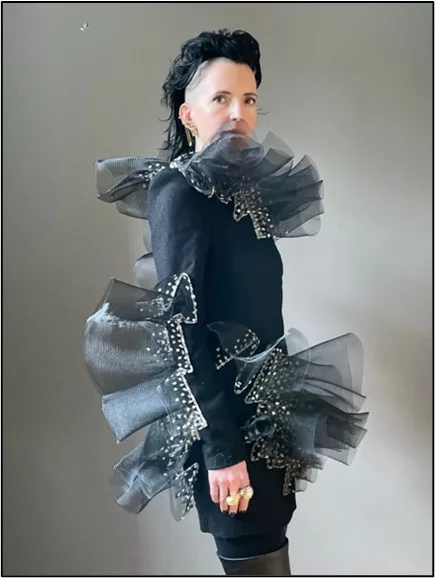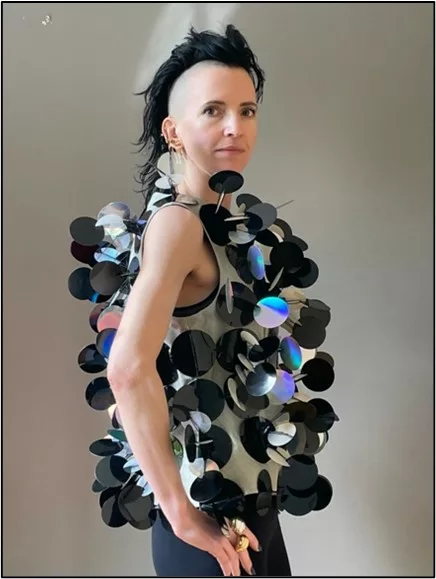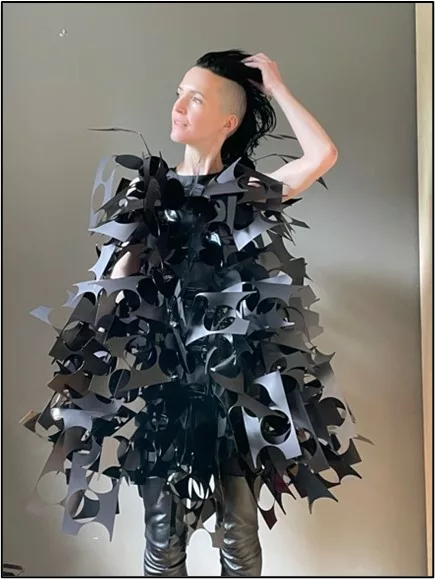Material INTO Practice, Practice ONTO Body and OUT TO Space
Exploration of sequins as a spatial concept through a new embellishment technique.
This practice-led PhD study brings together research about the history, materiality, and development of fashion embellishment, with a particular emphasis on sequins for the first time. It is an interdisciplinary PhD study using cultural studies, art histories, fashion practice and theory, and it expands the subject of embellishment to include sculptural methods as tools, selected fashion theory, spatial theory, and Derridean notions of ‘supplementarity’. This research foregrounds fashion practice to conceptualise the understanding of fashion embellishment for the first time using these selected tools and theories.
The practice produced for this study expands traditional embellishment by adapting sculptural tools for the first time to make visible the proxemic spaces that surround the body. This new embellishment technique, ‘the tensegrity technique’, embodies notions of space and fashion theory and discusses how clothing, and by extension embellishment when used on a garment, draws attention to how we occupy and move through the space of the world.
This thesis is driven by four distinct themes; ‘material’, ‘practice’, ‘body’, and ‘space’: from a consideration of the materials of fashion embellishment I move on to consider how they are used in practice and how, through garments and fashion, they are applied to the body; the materials and practice then extend beyond the parameters of the body and extend out to space. These four themes are the ‘building blocks’ of this study.
The ‘into’, ‘onto’ and ‘out to’ in the title of this project describes the journey of embellishment from loose components to three-dimensional volume applied to the garment and body to explore space. The materials of embellishment, components, and the base fabric, are converted into practice by hand; sequins are attached to fabric with thread. This practice is then applied onto the body via the carrier garment. The garment and body extend out to space through the development of a new embellishment technique. The above themes and prepositions enable this conceptualisation using a methodology prioritising practice underpinned by theory, and ‘design as research’. This project redefines and expands the understanding of what embellishment means and how it can be used spatially, with a novel and innovative methodology of employing sequins, thread, and beads to develop a sculptural form of embellishment that simultaneously defines the personal space of the wearer.
The Proxemic Dress
A dress made prior to the start of the study for a conference at Middlesex University (Body + Space, 2014). This garment was the starting point in terms of thinking about fashion embellishment as a spatial concept.

The Arnhem Bodice
A garment produced for this study that uses the tensegrity technique to make the ‘hard’ proxemic embellishments that cover the garment. The term ‘‘hard’ proxemic embellishment’ primarily refers to the choice of materials used for the structure and the outcome of an embellishment. Hard proxemic embellishments are rigid.

The Eclipse Dress
A dress produced for this study that uses the tensegrity technique to make the ‘soft’ proxemic embellishment that cover the dress. ‘’Soft’ proxemic embellishment’ refers to the choice of materials used for the structure and the outcome of an embellishment. The structures of the embellishments are less rigid and perhaps invite more interaction between wearer and viewer because of their tactility.
